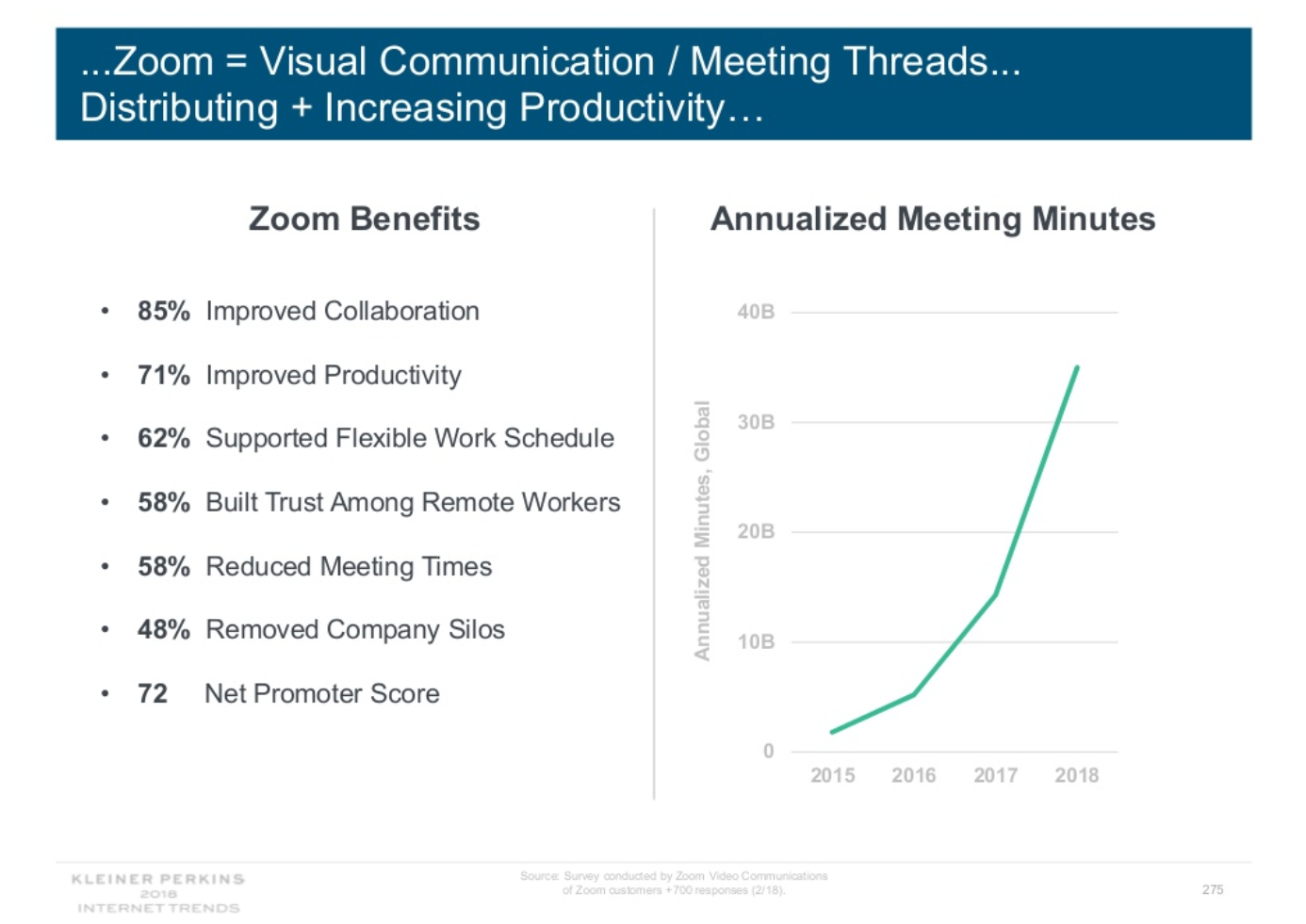- Mobile Video
2018 Internet Trends Report
Some internet trends may come and go, but many become transformative.
If software or an app or any technology in the Internet of Things can make us more productive in just about any aspect of our lives, we often embrace it with open arms. Amazon changed the way we shop, Uber changed the way we commute, Facebook changed the way we share information, YouTube changed how we learn something new, and the iPhone put it all in the palms of our hands.
There is, of course, no shortage of prognosticators forecasting which trends will be a flash in the pan and which will fundamentally change the way we live and work. But of them all, there is one report that business leaders, economists, and investors eagerly await each year: the annual internet trends report from Mary Meeker and her associates at Kleiner Perkins Caufield & Byers (KPCB).
The Big 2018 Enterprise Technology Trend: Messaging Threads
In this year’s report, Meeker and the team at KPCB identify what they call “Messaging Threads” — apps that support collaboration and the sharing of information — as the leading trend that’s dominated enterprise software over the last year.
The report highlights specific examples of popular enterprise tools like Slack, Dropbox, and rising star of the video conferencing market, Zoom, calling out their ability to help teams collaborate, exchange, and organize information across systems, making knowledge more accessible and useful.
While most businesses have had stand-alone systems in place for years to support collaboration (think video conferencing, instant messaging, and file sharing), the rate at which individual employees are moving to tools designed specifically to connect into other systems to expedite collaboration is reshaping the tech ecosystems of many organizations.

The 2018 Internet Trends report suggests that, through the adoption of these tools, employees are piecing together a worker-driven tech ecosystem that is better for organizing information, connecting teams, providing context, and showing historical data — all of which improve productivity significantly.
Looking Ahead: What’s The Next Enterprise Tech Trend?
We have the opportunity to work with hundreds of enterprise businesses whose own experiences confirm that Meeker and her analysts hit the nail on the head. The rapid switch to consumer-style productivity tools designed for professional use is reshaping the way organizations collaborate and share knowledge.
But there’s one tool missing from Meeker’s analysis that we expect to see in a future report: a video management app.
Video enables employees to communicate nearly anything in less time and with more depth than would be possible in a written email or document, particularly when it comes to demonstrating complex processes and teaching other employees something new.
The stratospheric growth in video usage within companies using Zoom’s video conferencing software — an 85% increase on average — shows just how much organizations will choose to collaborate and share information through video when they have access to tools that make it easy.

Details shared in meetings held over video conferencing apps, however, can be fleeting. To counteract our natural tendency to forget information over time, employees often use the recording feature built into apps like Zoom to capture collaborative sessions. The intention is to record meetings they may want to revisit later, but for this purpose, most communications tools offer no workable solution. Neither Zoom, nor Slack, nor even Dropbox make it easy to find a specific conversation, play it instantly, and share it securely with colleagues.
These popular apps simply aren’t designed for managing large video files or sharing videos of varying file formats. And if you’re thinking that YouTube could work — stop. YouTube isn’t secure enough for sensitive internal-facing video content (not to mention the other reasons you shouldn’t use YouTube).
Related Reading: The Way Businesses Manage And Share Internal Videos Is Broken
When the videos you’re talking about include a mix of internal meetings, institutional knowledge, executive messages, and other sensitive content that employees need to be able to find and share, organizations also need a secure, YouTube-like app for managing internal videos.
The good news is that such an app exists: a video content management system, (or video CMS, or “Corporate YouTube”) for short.
Here are some of the ways a video CMS can help employees boost productivity by making video communications and video-based knowledge easier to manage:
- Host videos securely in the cloud where they are easy to share and stream to any device
- Search everything spoken and shown on-screen inside your videos
- Live stream videos securely with no cap on viewers
- Integrate video into your existing systems so videos can be searched and played where people already go for information
Since consumer-grade enterprise collaboration apps are so big this year, we fully expect a similarly easy-to-use video management app for businesses to enter the mix in the near future. And Ms. Meeker, if you’re reading this, we’d love to talk!
A Video Content Management System:
The Best Enterprise Tool To Support Lightening Fast Learning And Communications
For a growing number of organizations, a video content management system delivers a new means to facilitate the management and delivery of video across a global organization. A video CMS provides cost-effective infrastructure for overcoming the unique challenges of managing a growing library of formal and informal internal video, and helps make video — including your Zoom recordings and more — an asset you can use to drive business growth.




